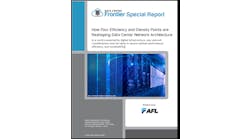In this week’s Voices of the Industry, David Mettler, IO Data Centers vice president of sales and market director for the United States, discusses how best to overcome data center migration challenges with a planned approach.
Today’s data center infrastructures support every organization and align to help drive the business strategy forward. So data center strategies must accommodate changing business and technology needs and be holistic, integrated and dynamic to ensure ample agility for today’s digital businesses.
David Mettler, vice president of sales and market director for the United States, IO Data Centers
In fact, today’s data center services may be on-premises, co-located, or in the cloud. Gartner says that “a multicloud strategy will become the common strategy for 70% of enterprises by 2019, up from less than 10% today.”[1]
In addition, fast-changing business needs—such as mergers and acquisitions, regulatory changes, the need to remotely access data, and security changes—can also necessitate a data center migration.
But with a data center migration come numerous challenges, such as application or other dependencies, poorly defined data requirements, distributed data and applications, lack of expertise or management support, and others. Understanding how to overcome them is key to a successful data center migration.
How Best to Overcome Migration Challenges
Gartner suggests that 70% of data center migrations will experience significant time delays or even unplanned downtime, largely due to improper planning.[2]
They go on to say: “Without proper planning and processes, data center migrations pose huge financial and operational risks to organizations. Understanding the primary steps required in a migration project is key to identifying what you don’t know and what resources will be required to prepare your project for success.”[3]
It’s incumbent upon the data center migration team to leverage best practices to leave no security gaps and ensure a tighter security posture than before. A well-defined data center migration should be seamless to end-users and minimize impacts on the business, such as downtime.
[clickToTweet tweet=”A well-defined data center migration should be seamless to end-users and minimize impacts on the business.” quote=”A well-defined data center migration should be seamless to end-users and minimize impacts on the business, such as downtime.”]
Best Practices for a Successful Data Center Migration
Given the immense risk of a data center migration, why do it? Even though the reasons may vary from organization to organization, all data center migrations share the need to discover, map, and inventory all existing data center assets so that you can successfully move, replace, or retire them.
- Planning & Strategy – Before undertaking this enormous risk, define why you need to perform a data center migration in the first place. Develop a data center migration strategy and goals, and then build a plan showing how the migration will go from start to finish.
- Assessment & Inventory – Next, assess application dependencies and conduct a complete inventory of equipment. Often, organizations will discover application dependencies not previously known or that need upgrades, sunsetted applications, or equipment that is no longer in use but is taking up valuable space. This is an opportunity to “clean house” and ensure that everything that needs to be moved is moved.
- Migration – With a solid data center migration strategy and plan in place, the data center migration should go smoothly. A data center migration checklist based on best practices can help ensure that inventoried equipment and/or applications are properly installed.
- Testing & Documentation – Once everything has been installed, testing will ensure that everything is running smoothly. Auditing and documenting the project—including goals, timelines, issues, resolution, etc.—can be the basis for compliance.
A Staged Approach to Scale as Needed
A staged migration allows you to gradually migrate and test applications and data in one stage before moving on to the next stage. For example, you might migrate lower priority data and applications first, and then move the rest of your applications and data over in due time.
This approach not only helps to reduce risk, it allows you to “test” your migration strategy and plan on data and applications that are less business-critical and resolve any issues going forward.
A staged migration allows you to gradually migrate and test applications and data in one stage before moving on to the next stage.
Critical to this approach is having the ability to align your data center capacity commitments with your actual usage requirements as you stage your migration. You don’t want to be forced to pay for capacity at the beginning of the migration that you won’t use until a later stage. One of the best ways to align capacity commitments with usage is via a modular data center approach, in which you provision smaller increments of data center capacity that directly align to your requirements at each stage of your migration. A modular data center provides greater control over capacity planning, which lowers your business risk, so you can easily migrate data and applications and pay only for what you use.
Understanding how data center migrations can go wrong is key to understanding how to perform them right. Following industry best practices—building a strategy and plan, assessing and inventorying your environment, performing the migration, and then testing and documenting—will help ensure success. A staged approach can help minimize risk, while a modular environment will provide the capacity needed when you need it—and save the costs of over-provisioning resources.
[1] “The Future of the Data Center in the Cloud Era,” Gartner.com, G00276114, 09/22/2016.
[2] Source: “Data Center Migrations – Five Steps to Success,” Gartner.com, #G00236380, 03/26/2014.
[3] Source: “Data Center Migrations – Five Steps to Success,” Gartner.com, #G00236380, 03/26/2014.
David Mettler is IO’s vice president of sales and the market director for the United States. Founded in 2007, IO is a data center services company that utilizes the latest data center technology to deliver colocation and cloud services to businesses and governments around the world. IO’s next-generation colocation offering gives enterprises the flexibility to deploy legacy and cloud applications in a secure and efficient environment. IO operates six state-of-the-art data centers in Arizona, Ohio, New Jersey, Singapore, and London. Trusted by some of the most demanding consumers of data center services, IO unleashes the potential for the data center to deliver sustainable business value.





